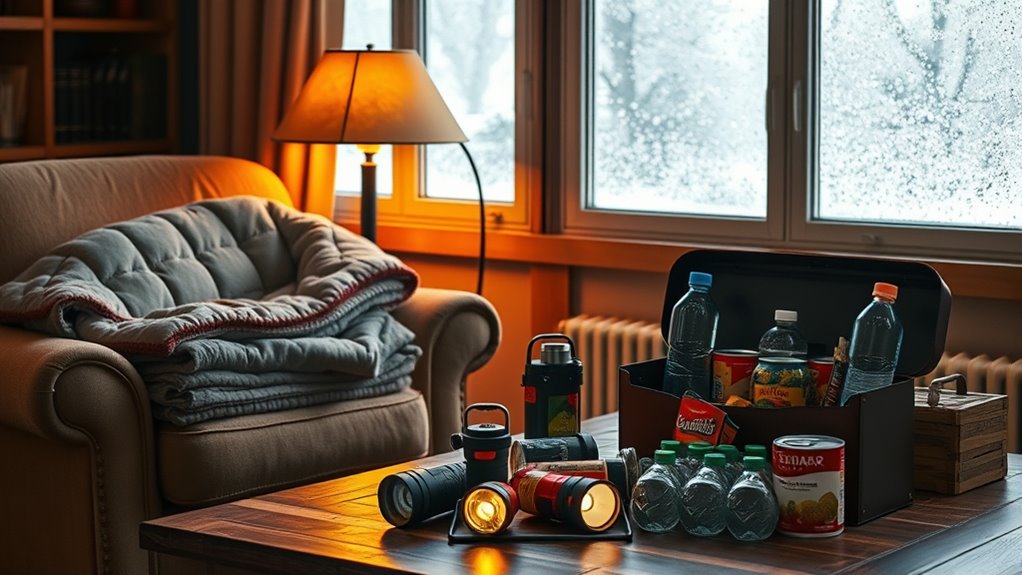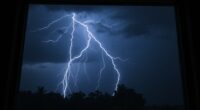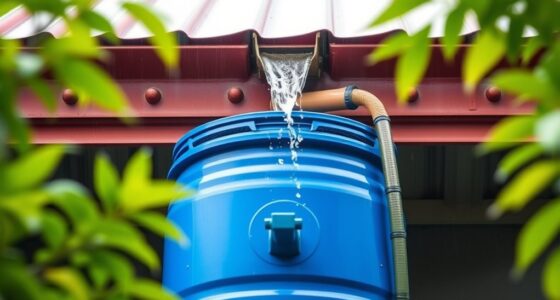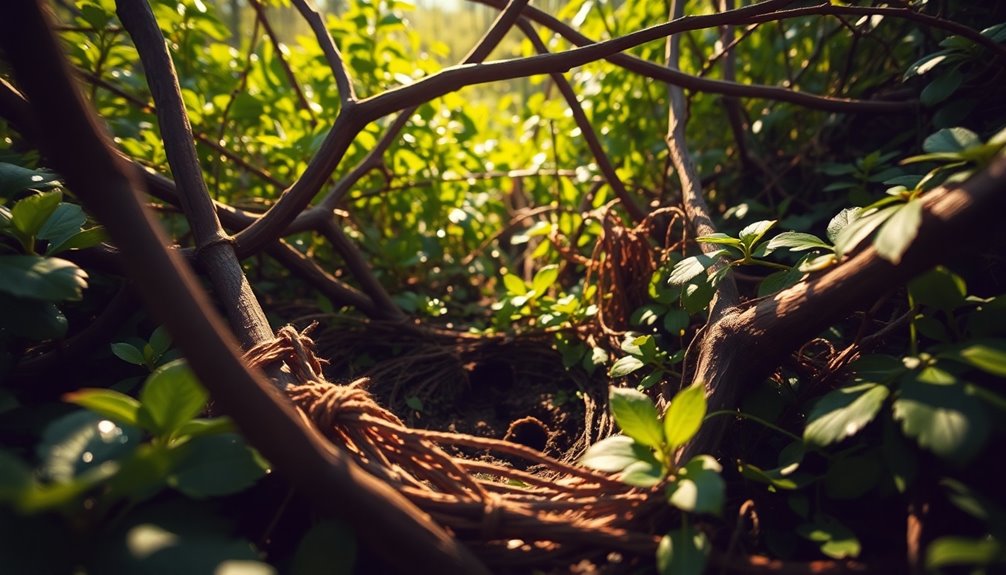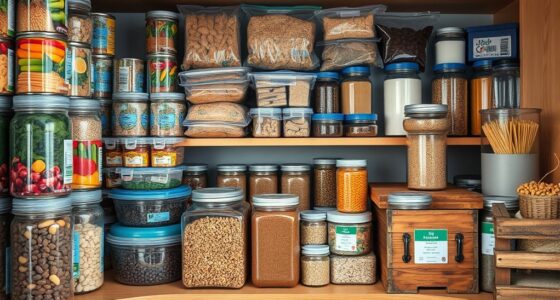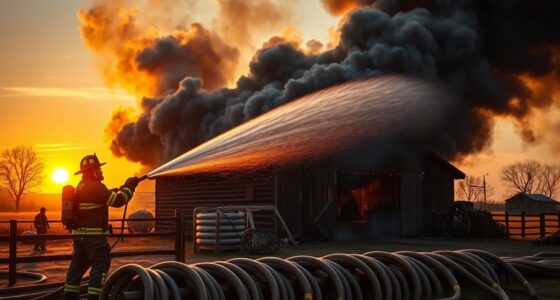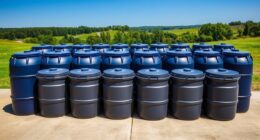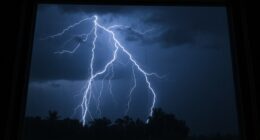To prepare for winter storms, make certain your home is well-insulated and properly ventilated to keep warmth in and reduce ice dam risks. Have an emergency kit stocked with warm clothing, blankets, water, and non-perishable food, along with flashlights and batteries for power outages. Consider backup heating sources like wood stoves or generators, but use them safely. Continuing your preparation will help you stay safe and comfortable through harsh winter conditions.
Key Takeaways
- Proper insulation and sealing of doors and windows maintain indoor warmth and reduce snow melt, preventing ice dams.
- Adequate attic insulation and ventilation keep the space cold, minimizing ice dam formation.
- Prepare an emergency kit with warm clothing, blankets, non-perishable food, flashlights, batteries, and portable chargers.
- Use backup heating sources like wood stoves or generators safely to maintain indoor temperature during power outages.
- Stay informed about weather conditions and have a clear emergency plan for quick response during winter storms.
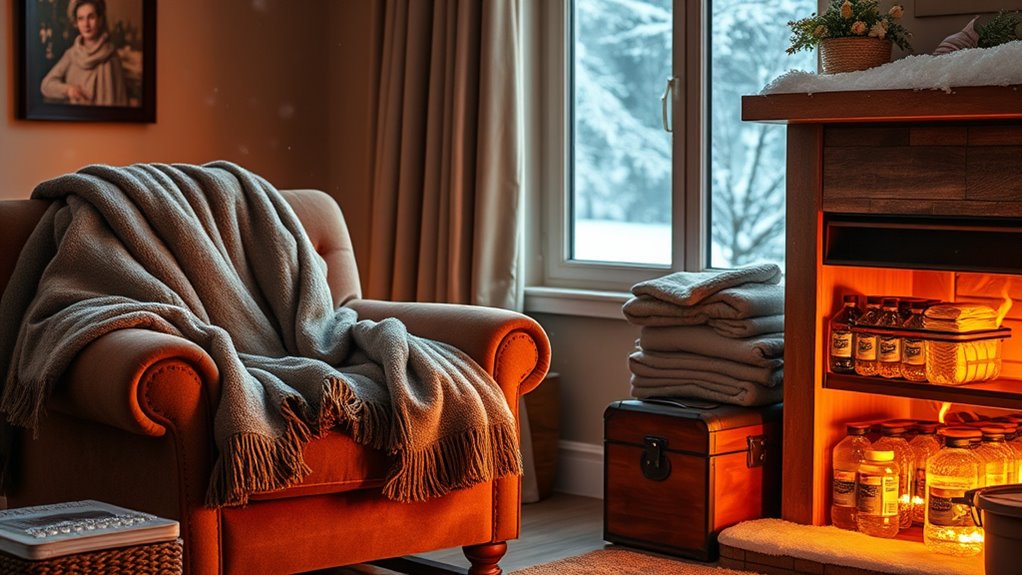
Are you prepared for the winter storm season? It’s essential to take steps now to protect your home and guarantee your safety during harsh weather. One common issue many face during winter storms is ice dams. These develop when warm air from your attic melts snow on the roof, which then refreezes at the edges, causing a dam that prevents melting water from draining properly. This can lead to water seeping into your home, damaging ceilings, walls, and insulation. To prevent ice dams, you should verify your attic is well-insulated and properly ventilated. Adequate insulation keeps your attic cold, reducing snow melt on the roof, while ventilation allows moisture to escape. Clearing snow from your roof with a roof rake can also help minimize ice dam formation.
Prevent ice dams by ensuring your attic is well-insulated and properly ventilated before winter storms arrive.
Power outages are another major concern during winter storms. Heavy snow and ice can weigh down power lines or cause trees to fall onto them, leading to outages that can last hours or even days. When the power goes out, your home can quickly become cold, especially if your heating system relies on electricity. That’s why it’s critical to have an emergency kit ready, including warm clothing, blankets, and non-perishable food. Keep flashlights, batteries, and a portable charger on hand to stay connected and safe. A backup heat source—like a wood stove or a generator—can be a lifesaver if the power stays out for an extended period. Remember to never use charcoal grills or propane heaters indoors due to the risk of carbon monoxide poisoning.
In addition to these precautions, insulating doors and windows helps retain heat inside your home, making it more comfortable and energy-efficient during winter storms. Sealing drafts around windows and doors can also prevent heat loss and keep your living space warmer longer. Consider installing storm windows or using weatherstripping as cost-effective ways to improve insulation. Preparing an emergency kit that includes bottled water, medications, and essential supplies is critical, especially if you live in an area prone to long power outages. Keep a supply of warm blankets and hats nearby, so you can stay warm if your heating system fails.
Being proactive during winter storm season means understanding these potential hazards and taking steps to mitigate them. By preventing ice dams, preparing for power outages, and insulating your home properly, you can reduce damage and stay safe. Stock up on supplies now, and make sure your emergency plan is clear. When winter storms hit, you’ll be ready to face whatever comes your way with confidence and resilience.
Frequently Asked Questions
How Can I Prevent Pipes From Freezing During a Winter Storm?
To prevent pipes from freezing during a winter storm, you should insulate your pipes with pipe insulation, especially those near exterior walls or in unheated areas. Don’t forget to insulate outdoor faucets with faucet covers or foam insulation. Keep cabinet doors open to allow warm air to circulate around pipes and let a slow drip of water flow to prevent freezing. These steps help protect your pipes effectively.
What Are the Best Types of Insulation for Extreme Cold?
For extreme cold, fiberglass and spray foam insulation are your best options because they provide excellent thermal barriers. When installing insulation, verify you cover pipes, walls, and attics thoroughly for maximum protection. Proper insulation installation traps heat inside and keeps cold air out, reducing the risk of freezing pipes. Consider adding reflective barriers or foam boards in especially vulnerable areas to boost thermal resistance during harsh winter conditions.
How Do I Keep My Pets Safe in Winter Storms?
Did you know that nearly 60% of pet deaths during winter storms are due to exposure? To keep your pets safe, bring them indoors during severe weather and provide a warm, dry shelter if they must stay outside. make certain they have access to fresh water and avoid using heated pads or blankets that could cause burns. Following winter weather precautions helps protect your furry friends from the dangers of cold temperatures.
What Should I Include in a Winter Storm Emergency Kit?
You should include essential items like winter clothing, such as warm hats, gloves, and boots, to keep yourself protected. Pack non-perishable food, bottled water, and a flashlight with extra batteries. Don’t forget important emergency contacts, like local shelters and medical services. Add a first aid kit, blankets, and any necessary medications. This way, you’re prepared to stay safe and comfortable during a winter storm.
How Can I Safely Heat My Home Without a Generator?
You can safely heat your home with alternative heating sources like a wood stove or space heater, but always follow safety precautions. Keep fire extinguishers nearby, guarantee proper ventilation to prevent carbon monoxide buildup, and never leave heaters unattended. Use only equipment designed for indoor use, and keep flammable objects away. Regularly check smoke and carbon monoxide detectors to protect yourself and your loved ones during winter storms.
Conclusion
Now that you’re equipped with insulation tips, heating ideas, and emergency kit essentials, you’re ready to face winter storms head-on. Remember, a little preparation can turn a blizzard from a nightmare into a manageable challenge. Don’t wait for the last minute—think of it as your own personal survival scroll. Stay warm, stay safe, and keep those lanterns handy; after all, even the most seasoned adventurers know that a well-prepared home beats a hobbit-hole in a winter’s storm.

